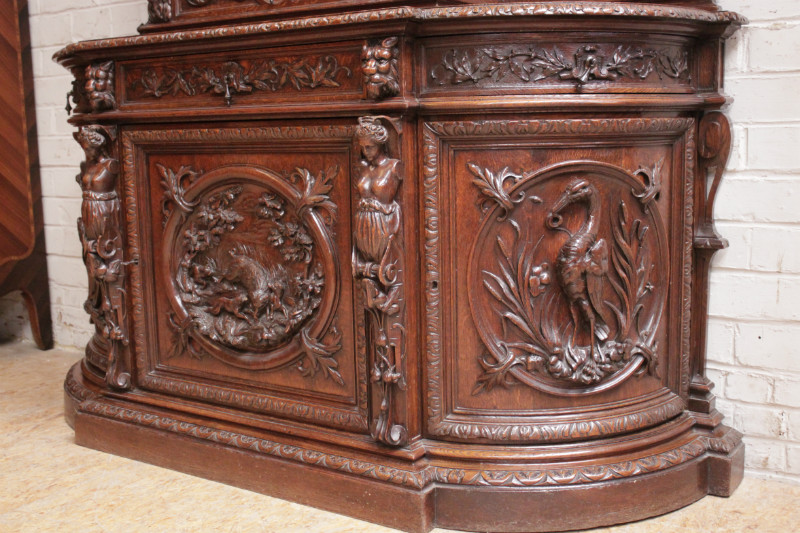I was standing in front of the most beautiful cabinet
and asked myself the question, ‘ What is the
meaning of all this carve work? What is the message
that the cabinetmaker wanted to convey?
This began a search for sources of information
which one could find simple meanings to aid in
the understanding of the symbols and allegories
that was once so widely used.
Traditional symbols form a universal language
which is becoming more mysterious
as we move further away from the thought
patterns of those who produced it. Originally,
these symbols – typically, familiar objects standing
for something abstract, such as an idea,
quality, emotion, value, aspiration, belief, hope
or fear – were anything but mysterious. Their intention
was to provide an instantly recognizable
representation, or mental picture, of a concept.
One must also take into consideration that signs
and symbols often overlap each other but have
different purposes and therefore we must make a
clear distinction between them. Signs represents
or provide information. Whereas symbols resembles
or give ordinary things a larger dimension
or deeper meaning, often a spiritual one.
Symbols do not have fixed meanings, some
are positive and some negative, it depends on
the changes in culture, different societies and
context. Attitude also played an important role
in the way the cabinetmaker or the designer
throughout history has expressed himself through
his works. The artist per se is partly responsible
in displaying societal attitude as to what was
going on during the period through his or her
design.
Many symbols are based on ancient myths of
powerful gods controlling wind and weather at
the four main directions – north, south, east and
west. The four seasons themselves represented a
cosmic order based on the number four. In many
traditions the repeating cycle of spring, summer,
autumn and winter symbolized a pattern of birth,
growth, decline and death which made sense
of the human cycle. There are also the four elements
– earth, air, fire and water- being the basis
of order and harmony. This led to the number
four acquiring extraordinary symbolic power
SIGNS AND SYMBOLS OF CARVED FURNITURE
FEATURE
and stood more widely for totality, stability and
universal power.
Symbolism is full of puzzles and symbolists often
disagree, differences of interpretation do not
make the symbols less valid but they do mean
that some knowledge of their cultural origins is
needed.
The Acanthus is a plant of the Mediterranean,
whose stylized leaves form the characteristic
decoration on most furniture. It is used on the
capitals of Corinthian pillars as friezes or end of
arm rests of chairs. The symbolism and meaning
associated with the Acanthus is that of enduring
life and immortality. The acanthus are also used
as a funerary motif to symbolize the prickly journey
of life to death, and then the ultimate triumph
of succeeding to the afterlife. The Roman writer
Vitruvius (circa 75 BC – circa 15 BC) related
that the Corinthian order had been invented by
Callimachus, a Greek architect and sculptor
who was inspired by the sight of a votive basket
that had been left on the grave of a young
girl. A few of her toys were in it, and a square
tile had been placed over the basket, to protect
them from the weather. An acanthus plant
had grown through the woven basket, mixing its
spiny, deeply cut leaves with the weave of the
basket. It was told that graveyard keepers saw
the acanthus as a weed and tried to exterminate
it but it keep on growing back and there for the
believe of immortality.
The Lion is commonly used in heraldry either
carved or on brass plaques on furniture also the
carved representation of a lion’s head is used
on furniture or a furry paw at the end of a furniture
leg. The lion is known as the “king of the
beasts,” and always a favorite animal symbol of
honor, courage, royalty, strength and leadership.
The lion appeared in early Greek and Roman
furniture, and found in French, English, and Italian
Renaissance designs.
The tree of life is a symbol of immortality and
eternal life With its branches reaching into the
sky, and roots deep in the earth, it dwells in three
worlds- a link between heaven, the earth, and
the underworld, uniting above and below. It is
both a feminine symbol, bearing sustenance,
and a masculine, visibly phallic symbol- another
union. The tree of life never died. Humanity was
cut off from the tree because they chose the
other and could not have both.
Pomegranate is a fruit that was used mostly to
decorate furniture on side panels or formed part
of the main carve work. It is normally carved in a
‘ripe’ open form, it was an attribute to the Greek
goddess Proserpina for her periodical return to
earth in the spring. In Christian art it is hope in immortality
and of resurrection. It is also a symbol
of fertility because of its many seeds.
There are just tons — think and you’ll come up
with even more!! Hope this jumpstarts your curiosity!


